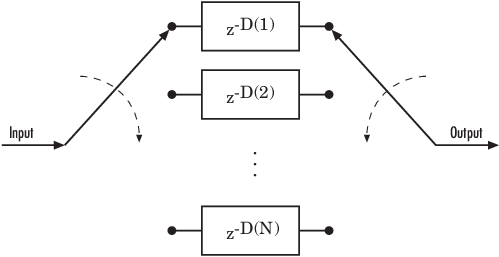Convolutional Interleaver
Permute input symbols using set of shift registers
Library
Convolutional sublibrary of Interleaving
Description
The Convolutional Interleaver block permutes the symbols in the input signal. Internally, it uses a set of shift registers. For information about delays, see Delays of Convolutional Interleaving and Deinterleaving.
The Initial conditions parameter indicates the values that fill each shift register at the beginning of the simulation (except for the first shift register, which has zero delay). If Initial conditions is a scalar, then its value fills all shift registers except the first; if Initial conditions is a column vector whose length is the Rows of shift registers parameter, then each entry fills the corresponding shift register. The value of the first element of the Initial conditions parameter is unimportant, since the first shift register has zero delay.
This block accepts a scalar or column vector input signal, which can be real or complex. The output signal has the same sample time as the input signal.
The block can accept the data types int8, uint8,
int16, uint16, int32,
uint32, boolean, single,
double, and fixed-point. The data type of this output will be the
same as that of the input signal.
Parameters
- Rows of shift registers
The number of shift registers that the block uses internally.
- Register length step
The number of additional symbols that fit in each successive shift register, where the first register holds zero symbols.
- Initial conditions
The values that fill each shift register when the simulation begins.
Examples
For an example that uses this block, see Convolutional Interleaving.
Pair Block
More About
References
[1] Clark, George C., and J. Bibb Cain. Error-Correction Coding for Digital Communications. Applications of Communications Theory. New York: Plenum Press, 1981.
[2] Forney, G., D., Jr. "Burst-Correcting Codes for the Classic Bursty Channel." IEEE Transactions on Communications, vol. COM-19, October 1971. 772-781.
[3] Ramsey, J. L. "Realization of Optimum Interleavers." IEEE Transactions on Information Theory, IT-16 (3), May 1970. 338-345.
Extended Capabilities
Version History
Introduced before R2006a

